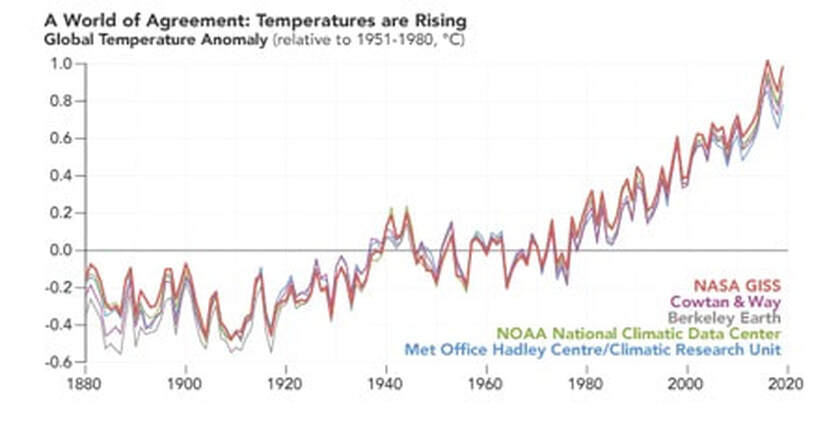 I am convinced that global warming leading to climate change, is a direct result of historic and on-going emissions of carbon dioxide (CO2) into the atmosphere by human agency. However, there are no certainties in the science behind climate change; science is not like that. Science is about the analysis of probabilities, the construction of theories, correlations, and probable cause and effect, backed up by intense peer review. Nevertheless, as they say in the interminable detective series on the TV at the moment, ‘Follow the evidence...’ Two things are abundantly clear: firstly, there is no doubt that for more than one hundred years, the average temperature on Earth has been rising. This rise has been far more rapid than the slow increase that has taken place over the previous 10,000 years or so since the last ice age. See below data from five independent sources:  There are far too many contemporary indicators to question whether the effect is real: the accelerating rise in sea level, the retreating Arctic ice-cap—resulting in the final opening up of the North West passage—the melting of glaciers in Greenland and the Antarctic, the bleaching of corals, the huge increase in extreme weather events all over the world, and so on. Secondly, the levels of carbon dioxide in the atmosphere have been increasing steadily since the start of the industrial revolution. Currently, the CO2 in the atmosphere is 50% higher than pre-industrial levels, when it had been more or less stable for at least 10,000 years. CO2 is the second most abundant greenhouse gas (after water vapour), and contributes to the warming of the atmosphere via the greenhouse effect. Atmospheric CO2 levels have fluctuated considerably over geological history; see, for example, the data from NASA on variations over the last 800,000 years:  The changes are very apparent, rising and falling every 100,000 years or so, and correlating with warm periods interspersed with ice ages. Note that the current level of CO2 is 50% higher than it has been for more than 800,000 years; it had been rising steadily over the last 10,000 years or so as the result of natural processes—well before large scale human activity—but the recent rise is so fast, it looks vertical on the graph. We have to ask ourselves two questions: does the current increase in atmospheric CO2 directly and unequivocally result from human activity? And if it does, is it responsible for, or does it contribute to, global warming? The graph below shows atmospheric CO2 from 1750 to the present (magenta line), and emissions of the gas from human activities—industry etc.—(blue line):  I defy any rational person whose mind is not permanently damaged by wild conspiracy theories, to deny that from 1970 or thereabouts there is an almost perfect correlation between the two, and that, therefore, the excess CO2 in the atmosphere is the result of industrial activity. But does increased CO2 in the atmosphere cause the planet to heat up? That is a far more difficult question. The graph below from NOAA (US National Oceanic and Atmospheric Administration) shows the concentration of atmospheric CO2 and global average temperature over the last 800,000 years: The level of correlation here is quite remarkable and is far too good for there to be any doubt that the two measures—atmospheric CO2 and global temperature—are very closely related. The $64,000 question is: does the one cause the other, or are both affected similarly by a more obscure effect? NOAA is quite candid: ‘While it might seem simple to determine cause and effect between carbon dioxide and climate from which change occurs first, or from some other means, the determination of cause and effect remains exceedingly difficult.’ In other words, the climate on Earth is complicated and is dependent on many factors; no easy answers regarding how it works emerge. One thing though is unequivocal; however complex is the interaction between the various contributors to the average global temperature, CO2 in the atmosphere appears to track it perfectly. So what has happened over the last hundred and forty years or so? The graph below shows average global temperate and atmospheric CO2: Over a period of 140 years to the present day, global average temperature tracks CO2 in the atmosphere; from the 1960s, the correlation is astonishingly good.
The conclusion seems inevitable and unavoidable: atmospheric CO2 is a very good indicator of average global temperature, and both are steadily increasing at a very much higher rate than pre-industrial levels. It certainly convinces me, as it does the majority of the world’s scientists. What does all of this this mean for the planet? The immediate global consequences of warming are: a steady increase in sea-level both from the simple expansion of the sea as it gets hotter, as well as melting glaciers; the doomsday scenario would occur if large parts of the ice sheet covering Antarctica, Greenland and elsewhere start to melt; most of Holland and much of the UK east coast—including London—would be inundated. In Asia, the Far East, and elsewhere, tens, possibly hundreds of millions of people in low lying areas will become displaced. A number of island nations will just disappear. Extreme weather events will result in life-threatening storms, wildfires, and floods becoming normal. More ominously, changes in climate will affect crop yields. There will be also be acute water shortages as parts of the planet heat up. ‘Existential’ is a very overworked word at present, but it is difficult to avoid the conclusion that climate change really is an existential crisis that will affect every person on the planet over the next fifty to one hundred years.
0 Comments
Leave a Reply. |
AuthorWelcome to the Mirli Books blog written by Peter Maggs Archives
March 2024
Categories |

 RSS Feed
RSS Feed